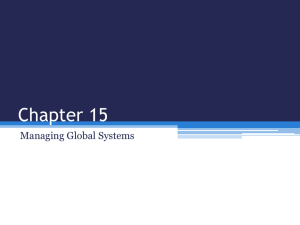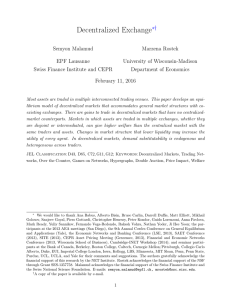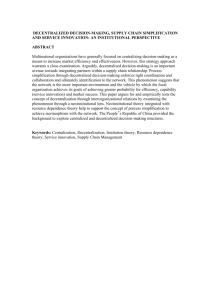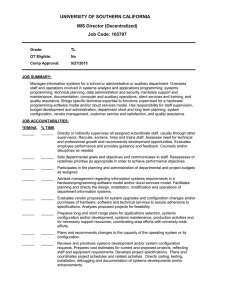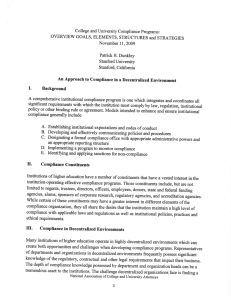An Approximate Dynamic Programming Approach to Decentralized Control of Stochastic Systems
advertisement
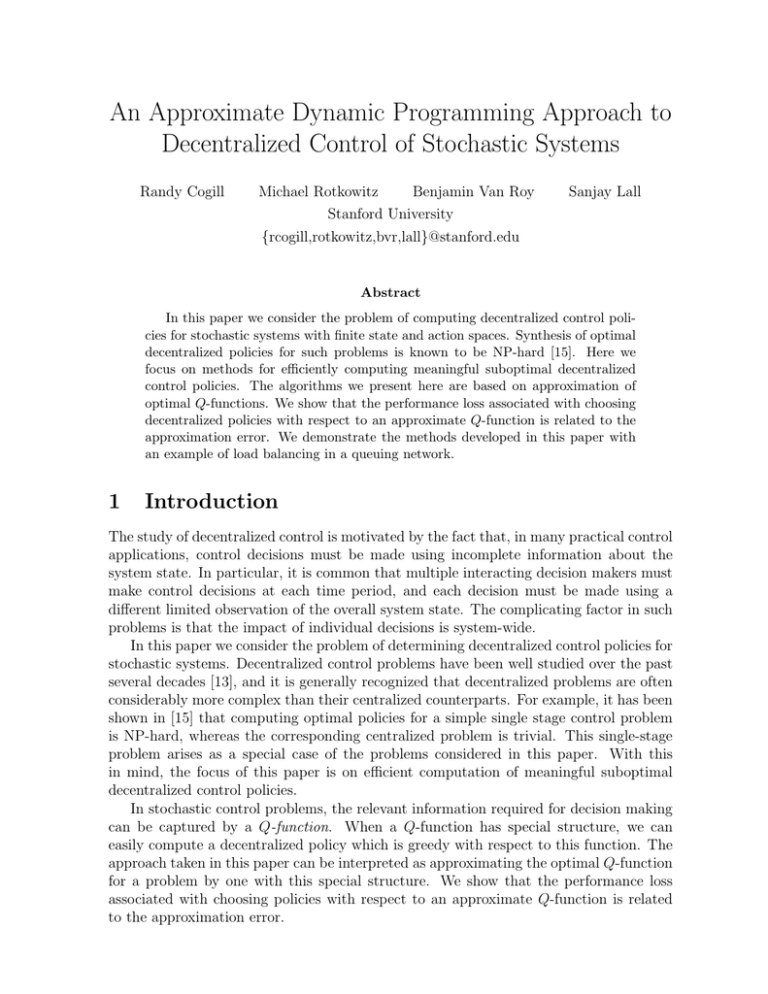
An Approximate Dynamic Programming Approach to
Decentralized Control of Stochastic Systems
Randy Cogill
Michael Rotkowitz
Benjamin Van Roy
Sanjay Lall
Stanford University
{rcogill,rotkowitz,bvr,lall}@stanford.edu
Abstract
In this paper we consider the problem of computing decentralized control policies for stochastic systems with finite state and action spaces. Synthesis of optimal
decentralized policies for such problems is known to be NP-hard [15]. Here we
focus on methods for efficiently computing meaningful suboptimal decentralized
control policies. The algorithms we present here are based on approximation of
optimal Q-functions. We show that the performance loss associated with choosing
decentralized policies with respect to an approximate Q-function is related to the
approximation error. We demonstrate the methods developed in this paper with
an example of load balancing in a queuing network.
1
Introduction
The study of decentralized control is motivated by the fact that, in many practical control
applications, control decisions must be made using incomplete information about the
system state. In particular, it is common that multiple interacting decision makers must
make control decisions at each time period, and each decision must be made using a
different limited observation of the overall system state. The complicating factor in such
problems is that the impact of individual decisions is system-wide.
In this paper we consider the problem of determining decentralized control policies for
stochastic systems. Decentralized control problems have been well studied over the past
several decades [13], and it is generally recognized that decentralized problems are often
considerably more complex than their centralized counterparts. For example, it has been
shown in [15] that computing optimal policies for a simple single stage control problem
is NP-hard, whereas the corresponding centralized problem is trivial. This single-stage
problem arises as a special case of the problems considered in this paper. With this
in mind, the focus of this paper is on efficient computation of meaningful suboptimal
decentralized control policies.
In stochastic control problems, the relevant information required for decision making
can be captured by a Q-function. When a Q-function has special structure, we can
easily compute a decentralized policy which is greedy with respect to this function. The
approach taken in this paper can be interpreted as approximating the optimal Q-function
for a problem by one with this special structure. We show that the performance loss
associated with choosing policies with respect to an approximate Q-function is related
to the approximation error.
A related approach for computing suboptimal policies for specially structured multiagent control problems can be found in [6]. The problems considered there have transition
probabilities modeled as a dynamic Bayesian network and structured single-stage costs.
The authors show that by using specially structured approximations to the cost-to-go
function, the required computations can be simplified.
The approach discussed in this paper resembles a method commonly used to synthesize decentralized control policies for linear time-invariant systems [2]. Semidefinite
programming conditions can be formulated for these problems which produce stabilizing
decentralized control laws when they are satisfied. These conditions involve a simultaneous search for a stabilizing control law and a Lyapunov function proving stability. The
Lyapunov functions used are restricted to have special structure, where the structure is
chosen to facilitate the search for a decentralized control law.
2
Dynamic Programming Background
In this paper we consider discrete-time stochastic control problems. The systems considered here have a finite state space X , and a finite set U of actions available at each
time step. Taking action u ∈ U when in state x ∈ X incurs a cost g(x, u). After taking
action u in state x, the system state in the next time period is y ∈ X with probability
p(y |x, u).
The goal is to find a rule for choosing actions which minimizes some measure of the
overall cost incurred. A rule for choosing actions is commonly referred to as a policy. A
static state-feedback policy µ : X → U is a rule which chooses an action based on the
current system state.
In this paper we consider the problem of choosing a policy to minimize the expected
total discounted cost:
¯
" ∞
#
¯
X
¯
J µ (x) = E
αt g(xt , µ(xt )) ¯ x0 = x ,
¯
t=0
where 0 ≤ α < 1. For any policy µ, we can compute the cost-to-go J µ by solving the
linear equations
X
J µ (x) = g(x, µ(x)) + α
p(y|x, µ(x))J µ (y).
(1)
y∈X
We can write these equations in matrix-vector notation as J µ = gµ + αPµT J µ . Here, gµ
is the cost vector evaluated for the policy µ, Pµ is the state transition matrix associated
with the policy µ, and PµT is its transpose. We can further simplify this equation using the
shorthand J µ = Tµ J µ , where the operator Tµ maps a vector J to the vector gµ + αPµT J.
This notation will be convenient in later sections.
For the expected total discounted cost criterion, there is a single policy which minimizes the cost-to-go for all initial states. Also, the minimum cost-to-go J ∗ is unique and
satisfies Bellman’s equation
Ã
!
X
J ∗ (x) = min g(x, u) + α
p(y|x, u)J ∗ (y) .
(2)
u∈U
y∈X
We can simplify notation by writing this equation as J ∗ = T J ∗ , where the operator T
maps a vector J to the vector T J defined as
Ã
!
X
(T J)(x) = min g(x, u) + α
p(y|x, u)J(y) .
u∈U
y∈X
It is often useful to work directly with the expression in the right hand side of Bellman’s equation. This is often referred to as a Q-function, and the optimal Q-function
Q∗ is given by
X
Q∗ (x, u) = g(x, u) + α
p(y|x, u)J ∗ (y).
y∈X
The optimal policy µ∗ is obtained from Q∗ by taking µ∗ (x) = argminu Q∗ (x, u). Like
cost-to-go functions, we can compute the Q-function associated with a particular policy
µ by solving the linear equations
X
Qµ (x, u) = g(x, u) + α
p(y|x, u)Qµ (y, µ(y)).
y∈X
We can introduce an operator Fµ and write the equations above simply as Qµ = Fµ Qµ .
Also, Bellman’s equation can be expressed directly in terms of Q functions as
³
´
X
Q∗ (x, u) = g(x, u) + α
p(y|x, u) min Q∗ (y, w) ,
(3)
w
y∈X
with Q∗ being the unique solution. As before, we can express this equation in the notation
Q∗ = F Q∗ , where the operator F maps a vector Q into a vector F Q satisfying
³
´
X
(F Q)(x, u) = g(x, u) + α
p(y|x, u) min Q(y, w)
y∈X
w
Q-functions will play an important role in the rest of the paper.
We will conclude this section by mentioning that the operators Tµ , T , Fµ , and F have
some important properties [3]. The following properties, presented only in terms of F
for convenience, hold for Tµ , T , Fµ , and F :
• Contractiveness: For any Q1 and Q2 , kF Q1 − F Q2 k∞ ≤ αkQ1 − Q2 k∞ . As a
result of the contraction mapping theorem, F has a unique fixed point Q∗ which is
obtained as the limit of the sequence {F n Q} for any Q.
• Monotonicity: For any Q1 and Q2 , if Q1 ≤ Q2 , then F Q1 ≤ F Q2 .
These properties will be used in the proofs of some upcoming theorems.
3
Computing Decentralized Policies
The problem of computing decentralized policies is considerably more complex than the
corresponding problem of computing centralized policies. For example, we can consider
the simple special case where α = 0. In this case, the optimal centralized policy is simply
µ∗ (x) = argminu g(x, u). On the other hand, we can consider a simple decentralized
variant of this problem where the state is described by two state variables x 1 and x2 and
each action is described by two decision variables u1 and u2 . The desired decentralized
policy µ chooses u1 based only on x1 and chooses u2 based only on x2 . Unlike the centralized problem, there may not be one decentralized policy which achieves lower cost
than all other decentralized policies at all states. Therefore, the problem of minimizing
expected cost may not be well defined until we specify an initial probability distribution
on the states. Once an initial distribution is specified, the resulting optimization problem is NP-hard [15]. This example highlights the importance of efficient algorithms for
computing meaningful suboptimal policies for decentralized control problems.
In the systems we consider, the action taken at each time period can be described by
a collection of decision variables as u = (u1 , . . . , uk ). The action space for this system is
U = U1 × · · · × Uk . Likewise, the state of the system is described by a collection of state
variables and the corresponding state space is X = X1 × · · · × Xp . In general, the policies
produced by dynamic programming determine each action ui based on the entire state
x = (x1 , . . . , xp ). However, we are interested in computing policies where each decision is
only based on a subset of the state variables. A decentralized policy is a policy in which
each action ui depends only on some specified subset of the state variables x1 , . . . , xp .
The required dependencies of actions on state variables is typically referred to as the
information structure of the desired policy. We will use the following notation to describe
the information structure of a particular policy. The set of variables which may be used
to decide action i is denoted as
Ii = {j | ui depends on xj }.
In particular, Ii gives the indices of the state variables that action i depends on. The
Cartesian product of the spaces of the variables used to decide action i is denoted as
Xi =
×X .
j
j∈Ii
Using this notation, a decentralized policy is a set of functions µi : Xi → Ui for i =
1, . . . , k.
Recall that the optimal centralized policy is the policy µ∗ (x) = argminu Q∗ (x, u),
where Q∗ is obtained as the unique solution to Bellman’s equation. P
Consider a policy
k
b
b
b
µ(x) = argminu Q(x, u), where Q is a function of the form Q =
i=1 Qi and each
Qi : Xi × Ui → R. Since ui is the only decision variable appearing in the argument of Qi ,
b u) is equivalent to choosing each ui to be argminu Qi (x, ui ).
choosing u to be argminu Q(x,
i
Also, since the only state variables appearing in the argument of Qi are those in Xi , the
choice of ui only depends on the values of the variables in Xi . Therefore, the policy µ
is decentralized since each decision ui is determined only in terms of the state variables
b is chosen to
in Xi . This suggests an algorithm, in which an appropriately structured Q
∗
b
approximate Q , and a decentralized policy is obtained from Q. Such an algorithm will
be presented in the next section. Theorem 1 justifies this approach by showing that the
suboptimality of the performance achieved by µ is related to the approximation error
b and Q∗ .
between Q
Before presenting Theorem 1, we will introduce some notation. Let Qµ denote the
function Q evaluated for the policy µ. That is, Qµ (x) = Q(x, µ(x)). We must be careful
to make the distinction between Qµ : X → R, the function Q evaluated for the policy µ,
and Qµ : X × U → R, the Q-function associated with following the policy µ from time
t = 1 onward. Also, let k · k1,ν denote the weighted 1-norm, defined as
X
kJk1,ν =
ν(x)|J(x)|,
x
where the weights ν are positive. For the upcomingPtheorem, we will restrict ourselves,
without loss of generality, to weights which satisfy x ν(x) = 1.
Theorem 1. Suppose Q satisfies Q ≤ F Q.
argminu Q(x, u), then the following bound holds
kJ µ − J ∗ k1,ν ≤
If µ is the policy defined as µ(x) =
1
kQ∗ − Qµ k1,ω ,
1−α µ
where ν is an arbitrary probability distribution on X and ω is the probability distribution
defined as ω = (1 − α)(I − αPµ )−1 ν.
Proof: First we will show that ω is a probability distribution. Let e denote the vector
with 1 for each entry. Since since eT ν = 1 and eT Pµt = eT for all t,
eT ω = (1 − α)eT (I − αPµ )−1 ν
∞
X
= (1 − α)
αt eT Pµt ν
= (1 − α)
t=0
∞
X
α t eT ν
t=0
= 1
Also, since Pµ ≥ 0 and ν ≥ 0 componentwise, ω ≥ 0.
Recall that we require Q ≤ F Q. By monotonicity of F , this implies Q ≤ F n Q for all
n. Since F n Q → Q∗ for any Q, this implies Q ≤ Q∗ . Also, the policy µ is greedy with
respect to Q, so Qµ ≤ J ∗ ≤ J µ . Therefore,
kJ µ − J ∗ k1,ν ≤ kJ µ − Qµ k1,ν
= ν T ((I − αPµT )−1 gµ − Qµ )
= ν T (I − αPµT )−1 (gµ − (I − αPµT )Qµ )
1
=
ω T ((gµ + αPµT Qµ ) − Qµ )
1−α
Since µ is greedy with respect to Q, we have (F Q)µ = gµ + αPµT Qµ . Therefore, the
inequality above can be expressed as
kJ µ − J ∗ k1,ν ≤
1
k(F Q)µ − Qµ k1,ω
1−α
Since Qµ ≤ (F Q)µ ≤ Q∗µ , we have the result
kJ µ − J ∗ k1,ν ≤
1
kQ∗ − Qµ k1,ω
1−α µ
¥
A theorem similar to Theorem 1, based only on cost-to-go functions, can be found in [4].
4
The Linear Programming Approach
It is well known that the solution to Bellman’s equation J ∗ can
P be obtained ∗by solving a∗
∗
linear program [9]. We can determine Q (x, u) = g(x, u) + α y∈X p(y|x, u)J (y) once J
is known. In the previous section, we outlined a method for computing a decentralized
policy based on an approximation of Q∗ . In this section, we present an algorithm for
computing such an approximation. This algorithm is based on an extension of the linear
programming approach to solving Bellman’s equation. The standard linear programming
formulation is extended to explicitly include Q. The need for including Q will become
clear shortly.
Theorem 2. The solutions to the equations (2) and (3) can be obtained by solving the
linear program
P
P
maximize:
x∈X
u∈U Q(x, u)
P
subject to: Q(x, u) ≤ g(x, u) + α y∈X p(y|x, u)J(y)
for all x ∈ X , u ∈ U
J(x) ≤ Q(x, u)
for all x ∈ X , u ∈ U
Proof: Q∗ satisfies
∗
Q (x, u) = g(x, u) + α
X
³
∗
´
p(y|x, u) min Q (y, w) .
y∈X
w
Also, J ∗ (x) = minu Q∗ (x, u) ≤ Q∗ (x, u) for all x, u. Therefore, Q∗ and J ∗ are feasible for
this LP.
Also, since J(x) ≤ Q(x, u) for any feasible J, any feasible Q satisfies
X
Q(x, u) ≤ g(x, u) + α
p(y|x, u)J(y)
y∈X
≤ g(x, u) + α
X
y∈X
³
´
p(y|x, u) min Q(y, w) ,
w
or more succinctly Q ≤ F Q. By monotonicity of F , this implies Q ≤ F n Q for all n.
Since F n Q → Q∗ for any Q, any feasible Q satisfies Q ≤ Q∗ . Therefore Q∗ is the optimal
feasible solution.
¥
Note that the usual LP approach to solving Bellman’s equation only involves J, and
therefore contains fewer variables and constraints. The explicit inclusion of Q in the
linear program is required because we will require Q to have special structure in order
to obtain a decentralized policy. In general, requiring J to have some special structure
is not sufficient to guarantee that Q will have the required structure.
Using this linear program, we have the following algorithm for computing a decentralized policy.
Algorithm 1.
b=
1. For any information structure, let Q
Qi : Xi × Ui → R and Ji : Xi → R.
Pk
b = Pk Ji , where
Q
and
J
i
i=1
i=1
2. For arbitrary positive values ω(x), solve the linear program
P
P
b
maximize:
x∈X
u∈U ω(x)Q(x, u)
b u) ≤ g(x, u) + α P
b
subject to: Q(x,
for all x ∈ X , u ∈ U
y∈X p(y|x, u)J(y)
b ≤ Q(x,
b u)
J(x)
for all x ∈ X , u ∈ U,
b u). This policy is decentralized with the desired information
3. Let µ(x) = argminu Q(x,
structure.
It is not immediately clear how the optimization problem solved in Algorithm 1 relates to
the cost-to-go achieved by µ. We will show that this optimization problem is equivalent to
b subject to some constraints.
minimizing a weighted norm of the error between Q∗ and Q
From Theorem 1, this error is directly related to the performance achieved by µ.
Theorem 3. The linear program in Algorithm 1 is equivalent to
b 1,Ω
minimize: kQ∗ − Qk
b ≤ F Q,
b
subject to: Q
where Ω(x, u) = ω(x) for all x ∈ X and u ∈ U.
b is feasible if and only if Q
b ≤ F Q,
b which implies
Proof: From the proof of Theorem 2, Q
b ≤ Q∗ . Therefore, for any feasible Q
b
Q
XX
b − Q∗ k1,Ω =
b u))
kQ
ω(x)(Q∗ (x, u) − Q(x,
x∈X u∈U
= −
XX
x∈X u∈U
b u) +
ω(x)Q(x,
XX
ω(x)Q∗ (x, u).
x∈X u∈U
P
P
ω(x)Q∗ (x, u) is constant, minimizing this quantity is equivalent to
Since
x∈X
P u∈U P
b u), the objective in the original LP.
¥
maximizing x∈X u∈U ω(x)Q(x,
From the previous theorem, we see that Algorithm 2 seeks to minimize the approximation
∗
b
b ≤ F Q.
b For any policy µ̂ and any probability
error kQ−Q
k1,Ω subject to the constraint Q
bµb − Q∗ k1,ω ≤ kQ
b − Q∗ k1,Ω holds. This, together with
distribution ω, the bound kQ
µ
b
Theorem 1, assures us that Algorithm 1 attempts to produce a decentralized policy µ
b
with performance close to that of an optimal centralized policy.
b (i.e., the centralized case), the weights ω in the
When no structure is imposed on Q
objective function are unimportant since we obtain Q∗ for any positive weights. However,
b has structure, the weights chosen will affect the quality of the policy obtained. A
when Q
good choice of weights may be guided by the interpretation of these weights in Theorem 1.
In particular, these weights impose a tradeoff in the quality of the approximation across
the states. Ideally, we would like to closely approximate states that are visited most
often under any policy. The role of these weights are discussed in greater detail in [4].
For highly decentralized information structures, the number of variables in the linear
program increases linearly with the number of state variables. Therefore, the number of
variables appearing in this linear program is often significantly less than the number of
variables required for computation Q∗ . However, the number of constraints appearing
in the linear program is still on the order of the number of state-action pairs. The
application of Algorithm 1 to large-scale problems may still be prohibitive due to the
large number of constraints. Similar problems are encountered in the application of the
approximate linear programming methods of [4] to large problems, however constraint
sampling has been shown to be an effective method for overcoming this problem [5]. We
believe that the analysis and application of constraint sampling as in [5] will carry over
to the problems discussed in this paper, although we have not explored the details at
this point.
5
Example
Consider the problem of load balancing among a collection of queues. In the formulation
discussed here, the goal is to keep the load at each queue relatively small by redirecting
jobs from heavily loaded queues to less loaded queues. The queues are networked, and
it is assumed that each queue can observe its own backlog, as well as the backlogs of its
immediate neighbors. At each time step, each queue must make a decision of whether
or not to pass a job to a neighboring queue, and if so, to which queue, based on its
observation. This is a decentralized control problem since each decision is made based
on incomplete information of the entire system state, but the dynamics of the queues are
coupled.
Here we will consider a simple example containing three queues each of capacity four, as
shown above. A small example is chosen since we can compute the optimal centralized
policy exactly and compare its performance with a decentralized policy computed by
Algorithm 1.
For each queue, a single job arrives in each time period with probability pin = 0.4
and a single queued job is served with probability pout = 0.48. Arrivals and services are
independent among the queues. At each time period, a backlog cost of cbl = x21 + x22 + x23
is incurred, where xi is the number of jobs currently waiting in queue i. Each time a job
is passed to a neighbor, a cost of cpass = 2 is incurred. Each time a job is lost due to
queue overflow, a cost of cof = 50 is incurred. Overflows occur when jobs arrive at or are
passed to a full queue.
700
700
Q*
Q
600
J*
J
600
500
500
400
400
300
300
200
200
100
100
0
0
0
500
1000
state-action pairs
1500
0
20
40
60
80
100
120
140
states
b calcuOn the left of the figure above, the optimal Q-function is shown along with Q
lated using Algorithm 1. For clarity of presentation, the state-action pairs are ordered
such that Q∗ is monotonic. We know from Theorem 3 that this algorithm aims to minimize a weighted 1-norm of the difference of these functions evaluated for particular
policies, so it is not surprising to see large differences for some state-action pairs. Adb computed by Algorithm 1
ditionally, it is shown in the proof of Theorem 2 that any Q
b ≤ Q∗ , as observed here.
satisfies Q
On the right we examine the cost-to-go functions associated with the policies obtained from these Q-functions. The cost-to-go J µ is calculated by first taking µ(x) =
b u) as in step 3 of Algorithm 1, and then finding J µ as in (1). Note again
argminu Q(x,
that this is different from the variable Jb from the linear program of Algorithm 1.
The states are ordered such that J ∗ is monotonic. We see that J µ is close to J ∗ for
each state. The algorithm thus gives a policy with the required decentralized structure
which performs similarly to the optimal centralized policy. In this case, we have an
intuitive sense that the ‘coupling’ among the two queues at the edges should be weak
under most policies, so it is not surprising to see that a decentralized policy can perform
nearly as well as the optimal centralized policy.
6
Conclusions
In this paper we considered the problem of designing decentralized control policies for
stochastic systems. An algorithm based on linear programming was presented. This
algorithm obtains a decentralized policy from a function with special structure that
approximates the optimal centralized Q-function. The performance loss associated with
the resulting decentralized policy was shown to be related to the approximation error.
References
[1] M. Aicardi, F. Davoli, and R. Minciardi. Decentralized optimal control of Markov
chains with a common past information set. IEEE Trans. Automatic Control,
32(11):1028–1031, 1987.
[2] J. Bernussou, P.L.D. Peres, and J.C. Geromel. Robust decentralized regulation:
a linear programming approach. Proc. IFAC Symposium on Large Scale Systems,
1:133–136, 1989.
[3] D. Bertsekas and J. Tsitsiklis. Neuro-dynamic Programming. Athena Scientific,
1996.
[4] D.P. de Farias and B. Van Roy. The linear programming approach to approximate
dynamic programming. Operations Research, 51(6):850–865, 2003.
[5] D.P. de Farias and B. Van Roy. On constraint sampling in the linear programming approach to approximate dynamic programming. to appear in Mathematics of
Operations Research, submitted 2001.
[6] C. Guestrin, D. Koller, and R. Parr. Multiagent planning with factored MDPs.
Advances in Neural Information Processing Systems, 14:1523–1530, 2001.
[7] Y.C. Ho. Team decision theory and information structures. Proceedings of the IEEE,
68(6):644–654, 1980.
[8] K. Hsu and S. Marcus. Decentralized control of finite state Markov processes. IEEE
Trans. Automatic Control, 27(2):426–431, 1982.
[9] A.S. Manne. Linear programming and sequential decisions. Management Science,
6(3):259–267, 1960.
[10] C. Papadimitriou and J. Tsitsiklis. Intractable problems in control theory. SIAM
Journal on Control and Optimization, 24(4):639–654, 1986.
[11] C. Papadimitriou and J. Tsitsiklis. The complexity of Markov decision processes.
Mathematics of operations research, 12(3):441–450, 1987.
[12] M. Puterman. Markov decision processes. John Wiley and Sons, New York, 1994.
[13] N.R. Sandell, P. Varayia, M. Athans, and M.G. Safonov. Survey of decentralized
control methods for large-scale systems. IEEE Trans. Automatic Control, 26, 1978.
[14] R. Srikant and T. Başar. Optimal solutions in weakly coupled multiple decision
maker Markov chains with nonclassical information. Proceedings of the IEEE Conference on Decision and Control, pages 168–173, 1989.
[15] J. Tsitsiklis and M. Athans. On the complexity of decentralized decision making
and detection problems. IEEE Trans. Automatic Control, 30(5):440–446, 1985.
